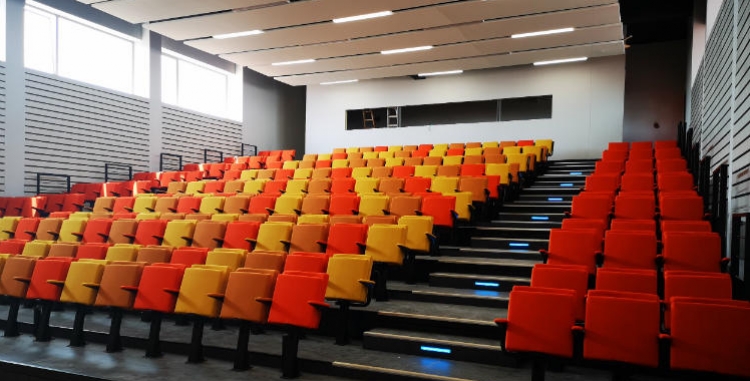In recent years, there have been some exciting innovations in the world of lecture hall and classroom design across the world, none more so than in the realm of seating and seating stand creation for tiered lecture halls.
Many universities, colleges, schools and academies are virtually unrecognisable compared with days of yore, where seating’s physical constraints could often hamper learning. In educational environments, the priority shouldn't dwell on designer brilliance, but more importantly, student success! Learners’ ability to learn effectively at lectures and classes as they work toward those all-important end of year exams is the number one consideration. Seating design experts recognise this and strive to provide lecture attendees with seats that facilitate learning in an unhindered way.
Telescopic Lecture Hall Seating
Not all learning is teacher directed, in a somewhat dated, one-to-many approach of ‘sharing oracular wisdom with the spellbound masses’. Often, students will be encouraged to learn in other problem-sharing and discussion-orientated non-didactic ways; whether active participation, buddying up, forming small groups, or even developing leadership skills through becoming principal contributors in a project. Sometimes, flat-floored space must be made available for this, and modern seating stands for lecture halls are designed with such flexibility in mind. As well as having comfortable and supportive seats with accessories to allow the use of tablets, for example, the stands themselves can be modular, retractable and mobile. Remote or manual control can be used to release floor-space whenever required, without reducing room occupancy levels overall or intruding upon the line of sight (from seats) towards front-of-room activities or lecturing.
Take Account of Present Needs While Planning For The Future
Initially, your seating designer will want to know if you have some thoughts around key requirements, including:
- What exactly will the hall be used for, and how frequently? Perhaps the hall is to be used for daily lectures for the coming year, but might it be utilised as a multipurpose space later?
- How big is the room?
- Is it a low or high ceiling?
- How many seats will be required?
- Would modular seating be best, so that additional modules can be added to increase capacity?
- Is a telescopic lecture hall seating stand the ideal option at this particular site; or is seat retraction rarely going to be necessary?
- Might there be occasions where the seating stand must be completely removed?
With answers to these questions, seating experts can commence drawing up initial designs, working towards a solution that suits the venue perfectly, and offers scope for the future, when the lecture hall might host a diverse range of events.
Re-imagining Lecture Hall Seating
Not all venues require flexible seating, of course; sometimes, fixed seating can be ideal, and many establishments are content to ‘stick with fixed’ in their lecture halls - but perhaps still feel dissatisfied with the chair quality. A seat upgrade can make a major difference if you want to give your learning environment a fresh feel. It avoids the expense of entirely replacing a seating stand. Seat upgrades or refurbishments can be done quickly and efficiently meaning disruption to busy lecture timetables are minimal. Whatever your plans, the journey from re-imagining your learning space to delivering it needs to put what's most important to you and your students front and center - and that's the very best place to begin.












 © 2025 All rights reserved.
© 2025 All rights reserved.